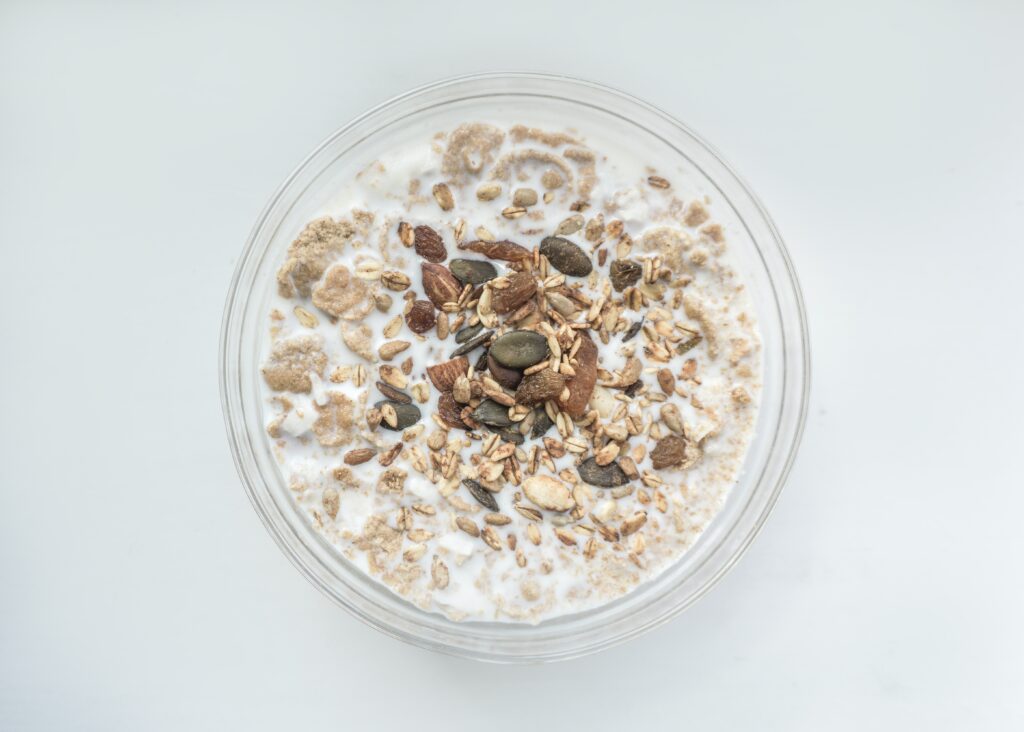
Yogurt is a healthy food that is loved by many. It is a great source of protein and calcium and can be enjoyed in many ways, from eating it on its own to using it in recipes. But can you freeze yogurt? The short answer is yes, you can freeze yogurt, including Greek yogurt. However, there are some things you need to know before freezing yogurt.
Benefits of Freezing Yogurt
Freezing yogurt offers several benefits, both in terms of nutrition and convenience. Here are some of the key advantages:
- Extended Shelf Life: Freezing yogurt can significantly extend its shelf life. This is particularly useful if you have bought yogurt in bulk or can’t consume it before the expiration date.
- Cool Treat: Frozen yogurt serves as a healthier alternative to traditional ice cream. It’s a great way to enjoy a cold, creamy dessert with less fat and fewer calories, depending on the type of yogurt used.
- Preservation of Probiotics: While freezing can slow down the activity of the probiotics (beneficial bacteria) in yogurt, it doesn’t kill them. Once thawed or consumed, these probiotics can become active again and contribute to gut health.
- Versatility in Recipes: Frozen yogurt can be used in various recipes, like smoothies, which makes it a versatile ingredient. It adds creaminess and nutritional value to these dishes.
- Portion Control: Freezing yogurt in specific portions (like in ice cube trays or small containers) can aid in portion control, which is beneficial for those monitoring their food intake.
- Nutrient Retention: Freezing preserves the nutritional content of yogurt, including its calcium, essential proteins, and B vitamins, ensuring you get these benefits even after long-term storage.
- Convenience: Having frozen yogurt on hand means you always have a base for smoothies or a quick snack readily available, which can be a convenient option for busy lifestyles.
- Reduced Food Waste: By freezing yogurt, you can reduce food waste, as it allows you to store and use yogurt that might otherwise spoil.
While freezing yogurt offers many benefits, it’s important to note that the texture of yogurt can change once frozen and thawed. It might become a bit grainy or separated, but this doesn’t affect its taste or nutritional value. For eating thawed, gently stirring it can help improve the texture.
The Effects of Freezing on Yogurt
When you freeze yogurt, the texture and consistency of the yogurt will change. Freezing causes the water in the yogurt to expand, which can result in a grainy texture once thawed. Additionally, the yogurt may separate when thawed, resulting in a watery consistency. However, if you plan on using frozen yogurt in a recipe, this change in texture may not be a concern.
How to Freeze Yogurt
Freezing yogurt is a simple and straightforward process. Here’s a step-by-step guide on how to do it:
- Choose the Right Type of Yogurt: Full-fat yogurts tend to freeze better than low-fat or fat-free options, as they have a creamier texture. Greek yogurt is also a good choice due to its thick consistency.
- Preparation: If you want to sweeten your yogurt or add flavors, do so before freezing. You can mix in honey, sugar, vanilla extract, or pureed fruits.
- Container Selection: Select the appropriate container for freezing. You can use the original yogurt container (if it’s not full), ice cube trays for small portions, or airtight containers for larger quantities. For yogurt pops, use popsicle molds.
- Freezing in Portions: If you plan to use the yogurt in smoothies or as a snack, consider freezing it in portion-sized amounts. Ice cube trays are great for this purpose. Simply pour the yogurt into the tray and freeze.
- Freezing Yogurt Bark: For a snack-like option, spread yogurt on a baking sheet lined with parchment paper, add your desired toppings (like fruits, nuts, or chocolate chips), and freeze. Once solid, break into pieces.
- Label and Freeze: Mark the container with the date. This is helpful for tracking how long the yogurt has been in the freezer.
- Freezing Time: Place the container in the freezer and freeze until solid. This usually takes a few hours, depending on the quantity and temperature of your freezer.
Remember, while freezing will preserve the yogurt for a longer time, it’s best to consume it within a month or two for optimal taste and texture. Also, frozen yogurt is perfect for making smoothies, as you can use it directly from the freezer without thawing.
How long does yogurt last in the freezer
Yogurt can be stored in the freezer for up to two months. While freezing yogurt extends its shelf life beyond what’s possible in the refrigerator, it’s important to consider the following points:
- Quality Over Time: The longer yogurt is stored in the freezer, the more likely it is to experience changes in texture and taste. It’s best consumed within two months for optimal quality.
- Probiotic Viability: While freezing doesn’t kill the probiotics in yogurt, their activity is significantly reduced. Once thawed, these beneficial bacteria can become active again, but their levels might be lower than in fresh yogurt.
- Container Matters: Make sure to store yogurt in an airtight container or tightly sealed to prevent freezer burn and absorption of odors from other foods in the freezer.
- Texture Changes: After thawing, frozen yogurt might separate or become grainy. Stirring it can help improve the texture, but it might not return to its original state.
- Direct Use: For uses where thawing isn’t necessary (like in smoothies), frozen yogurt can be a convenient ingredient straight from the freezer.
Remember to label the container with the freezing date to keep track of how long it’s been stored. This ensures you use the yogurt while it’s still at its best quality.
Ways to Freeze Yogurt
Freezing yogurt is a simple and versatile process that can transform it into a delicious, frozen treat. Here are some ways to freeze yogurt:
- Freeze in Ice Cube Trays: Pour yogurt into ice cube trays and freeze. These cubes can be used in smoothies or eaten as a cold snack.
- Yogurt Popsicles: Mix yogurt with fruits or honey, pour into popsicle molds, and freeze. This makes a healthy and refreshing snack, especially in hot weather.
- Frozen Yogurt Bark: Spread a thin layer of yogurt on a baking sheet lined with parchment paper. Add toppings like nuts, fruits, or chocolate chips, and freeze. Once solid, break into pieces and enjoy.
- Pre-Made Frozen Yogurt Cups: Fill small cups or containers with yogurt and freeze. These are great for quick, portion-controlled snacks.
- Yogurt Parfait Freezes: Layer yogurt with fruits and granola in a cup and freeze. This creates a frozen version of a yogurt parfait.
- Blended Frozen Yogurt: Blend yogurt with fruits and freeze the mixture. This can be served as a soft-serve style frozen yogurt.
Remember to use full-fat yogurt for a creamier texture, and consider sweetening or flavoring it before freezing for added taste. The freezing process can affect the texture of yogurt, so experimenting with different methods can help you find the one that best suits your taste preferences.

Can you freeze Greek yogurt
Yes, you can freeze Greek yogurt. Freezing Greek yogurt extends its shelf life and can be useful for using it later in smoothies, baking, or as a frozen treat.
Although it’s important to avoid freezing Greek yogurt that has already been sweetened or has added fruit. These ingredients can change the texture and flavor of the yogurt once frozen.
The shelf life of frozen Greek yogurt is typically 2-3 months, but it’s best to consume it before the expiration date on the original container.
Freezing Greek yogurt is a great way to reduce food waste and always have some on hand for recipes or snacks.
Suggested: Can you Freeze Almond Milk? Here’s How
How to Freeze Yogurt in an Ice Cube Tray
One way to freeze yogurt is by using ice cube trays. This is a great option if you only need a small amount of frozen yogurt for a recipe. Simply spoon the yogurt into an ice cube tray and freeze until solid. Once frozen, pop the yogurt cubes out of the tray and store them in an airtight freezer container or bag. When you need to use the frozen yogurt, simply thaw the desired number of yogurt cubes.
How to Thaw Yogurt
Thawing frozen yogurt is a simple process, but it’s important to do it correctly to avoid any changes in texture or flavor. Here are the steps to follow to thaw yogurt:
- Move the yogurt to the refrigerator. The first step to thawing frozen yogurt is to move it from the freezer to the refrigerator. Place the container of frozen yogurt on a shelf in the fridge where it can thaw slowly and evenly. It’s best to give the yogurt several hours or overnight to thaw, depending on the amount and size of the container.
- Don’t rush the process. Avoid using a microwave or placing the yogurt in warm water to speed up the thawing process. These methods can cause the yogurt to melt unevenly and may even result in the yogurt separating or becoming watery.
- Stir the yogurt. Once the frozen yogurt has thawed completely, remove it from the fridge and stir it well. The yogurt may have separated during the freezing process, but stirring it will help to bring it back together and restore its smooth texture.
- Check the consistency and flavor. After stirring the yogurt, check the consistency and flavor to make sure it hasn’t been affected by the freezing and thawing process. If the yogurt has an off-flavor or watery consistency, it may have freezer burn and should be discarded.
Tips for Thawing Frozen Yogurt
- Frozen yogurt should be consumed within a few days of thawing to maintain its quality and freshness.
- If you portioned the frozen yogurt into smaller amounts, you can thaw only what you need instead of thawing the entire container.
- Greek yogurt may have a slightly grainy texture after thawing, but this is normal and doesn’t affect the taste or quality of the yogurt.
By following these simple steps, you can easily thaw frozen yogurt without compromising its texture or flavor. Just be sure to take your time and avoid rushing the process to ensure the best results.
Can you Refreeze Yogurt?
It’s generally not recommended to refreeze yogurt once it has been thawed. Refreezing can further alter the texture, making it grainy or separated, and can also affect the taste. Additionally, if the yogurt was thawed at room temperature for an extended period, there might be a risk of bacterial growth, which could make it unsafe to eat. For best quality and safety, it’s better to only thaw the amount of yogurt you plan to use and keep the rest frozen.

Ways to use Frozen Yogurt
Frozen yogurt can be used in a variety of delicious and creative ways. Here are some ideas:
- Smoothies and Shakes: Use frozen yogurt cubes or chunks as a base for smoothies and shakes. They add creaminess and a tangy flavor, and can be combined with fruits, juices, and other ingredients.
- Frozen Desserts: Frozen yogurt can be a great alternative to ice cream. Serve it as is, or add toppings like fruits, nuts, honey, or chocolate sauce. You can also blend it to create a soft-serve texture.
- Yogurt Popsicles: If you’ve frozen yogurt in popsicle molds, enjoy them as a healthy and refreshing treat on a hot day. Mix yogurt with fruits or honey before freezing for added flavor.
- Baking: Use frozen yogurt in baked goods as a substitute for buttermilk or regular yogurt. It works well in cakes, muffins, and bread, adding moisture and a slight tanginess.
- Parfaits: Layer thawed frozen yogurt with granola, fruits, and nuts to create a delicious parfait. This can be a healthy breakfast option or a dessert.
- Cooking: In savory dishes, thawed yogurt can be used in marinades, dressings, or as a topping for soups and stews, adding a creamy texture and a bit of tang.
- Frozen Yogurt Bars: Cut the frozen yogurt into bars or squares for a quick, portable snack. You can coat them with melted chocolate or other coatings for added flavor.
- Ice Cream Sandwiches: Use cookies or wafers to sandwich a scoop of frozen yogurt in between, creating a homemade ice cream sandwich.
- Fruit Dips: Thawed or semi-frozen yogurt can be used as a dip for fresh fruit slices. Blend it with a bit of honey or maple syrup for added sweetness.
These ideas showcase the versatility of frozen yogurt, making it a valuable addition to both sweet and savory recipes.

Final Thoughts
Freezing yogurt is a great way to extend its shelf life and reduce food waste. While the texture of the yogurt may change once frozen, it can still be used in recipes and enjoyed as a healthy snack. Be sure to use an airtight freezer container and label the container with the date and type of yogurt to ensure its shelf life.

Christopher is a food and lifestyle expert, recipe developer and the content creator behind May Eighty Five. With years of experience in the kitchen, he also shares tips, tricks and how to’s that he has learnt over the years. Every week, he shares quick, simple and mostly healthy recipes along with some home and entertaining tips. You will find flavorful cocktails, delicious appetizers, tasty mains and some indulgent desserts. As a home decor enthusiast, he also likes to share simple DIY projects and simple tips for a beautiful home.








14 Comments